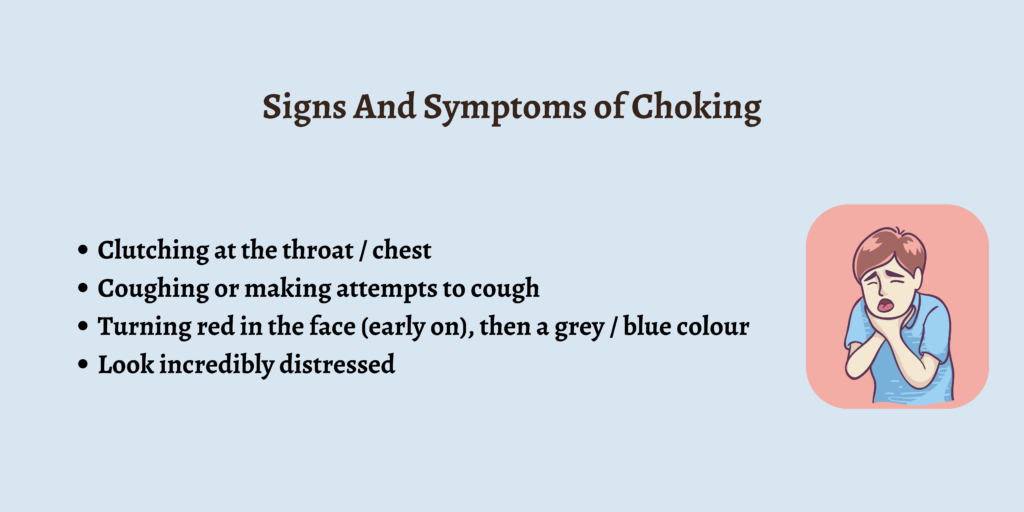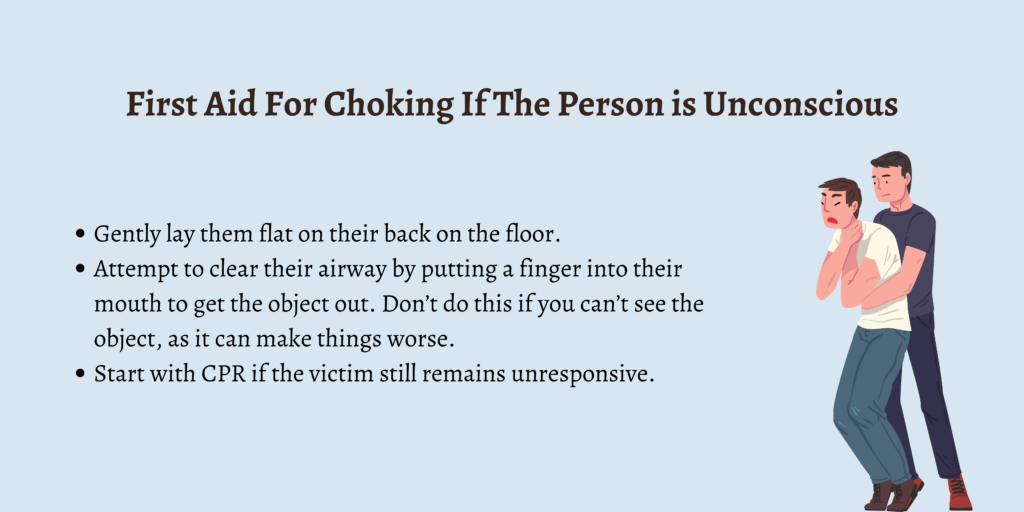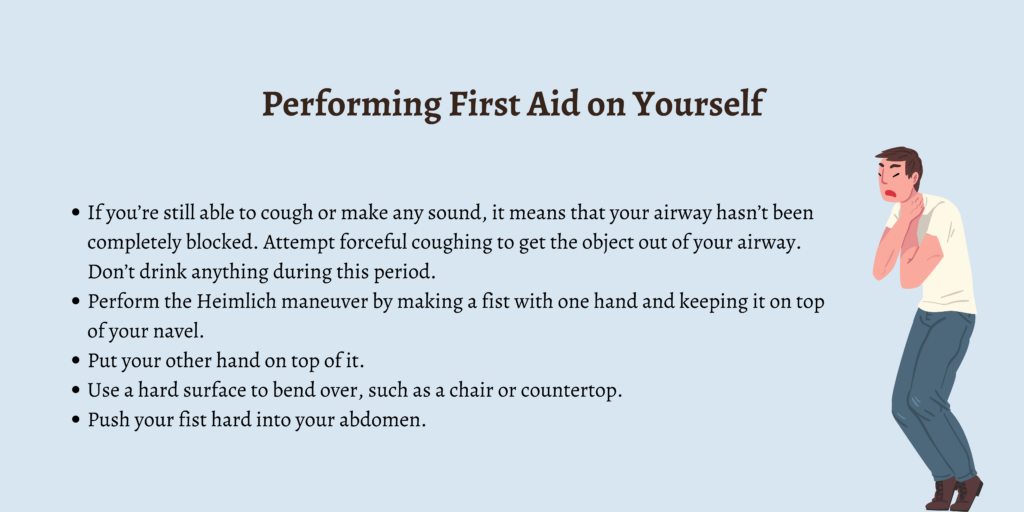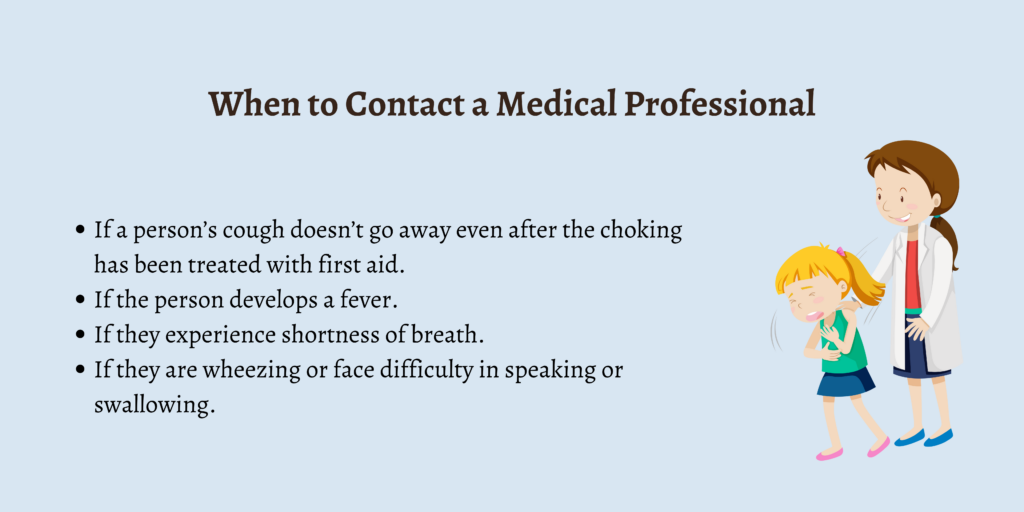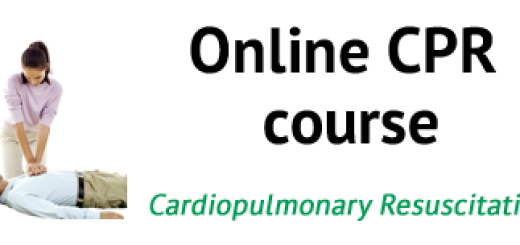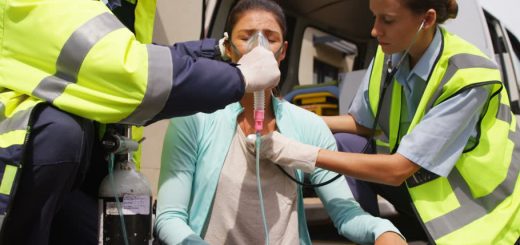First Aid For Choking
Choking refers to a blockage of a person’s upper airway due to food or other objects, thereby preventing them from breathing properly. It can either just lead to a coughing fit or completely block the airway in a manner such that it causes the death of the individual.
Adults usually choke due to a piece of food, and choking happens in children owing to them swallowing smaller objects. Since choking prohibits oxygen from getting supplied to the brain, it can be life-threatening, which is why first aid should be provided immediately to save a person’s life.
In order to understand choking, it’s important to understand the mechanism behind it:
- When we breathe in oxygen, it travels to the rest of the human body after entering the bloodstream. This oxygen is used as a source to create energy from the food we consume.
- As we exhale, we breathe out nitrogen, carbon dioxide, and oxygen.
- When we choke, it’s due to a blocked airway which doesn’t allow oxygen to get into the lungs, thereby affecting the brain. First aid for choking needs to be provided at this point so as to prevent brain death.
In this article, we will be discussing first aid for choking in different scenarios, how choking can be prevented, and much more.
Signs And Symptoms of Choking
The following are common signs and symptoms of choking:
- Clutching at the throat / chest
- Coughing or making attempts to cough
- Turning red in the face (early on), then a grey / blue colour
- Look incredibly distressed
First Aid Treatment For Choking
If the casualty can cough – partial airway obstruction
Step 1: Encourage the casualty to cough as best they can. Encourage them to keep coughing until the object is dislodged.
Step 2: Monitor and be prepared to intervene.
If the casualty can’t cough – complete airway obstruction
Step 1: Lean the casualty forwards. Deliver five sharp blows to their back, in between the shoulder blades
Step 2: If unsuccessful, deliver five abdominal thrusts (see video below on how to perform these).
Step 3: Continue delivering cycles of back blows and abdominal thrusts until the object is dislodged. Stop and call an ambulance after the third cycle if one hasn’t already been called.
If the object is dislodged, the casualty should still seek medical advice for a checkup especially if someone has performed abdominal thrusts as these can cause internal injuries
First Aid For Choking If The Person is Conscious
If the person who is choking is conscious, the first aid that is to be administered to them includes the following steps:
- The person will have to be given a back blow. Start by standing behind them and remain slightly more towards one side. Use your hand to support their chest.
- In order for the object to come out of their mouth, lean them forward.
- Use the heel of your hand to give them five sharp blows between their shoulder blades and check to see if the blockage has been cleared.
- If the blockage is still there, go ahead with abdominal thrusts.
- In order to perform an abdominal thrust, stand behind them and bend them forward after placing your arms around their waist.
- Clench your fist and put it above their belly button.
- Use your other hand to put it on top of the fist and pull it upwards and inwards in sharp motions.
- Do this five times.
First Aid For Choking If The Person is Unconscious
If a person becomes unconscious while choking:
- Gently lay them flat on their back on the floor.
- Attempt to clear their airway by putting a finger into their mouth to get the object out. Don’t do this if you can’t see the object, as it can make things worse.
- Start with CPR if the victim still remains unresponsive.
What Not to Do While Assisting a Person Who is Choking
The one thing that you should not do while assisting someone who is choking is that don’t slap them on their back while they are upright. This is because if you do so, then gravity could lead to the object moving further down the victim’s windpipe.
Cardiopulmonary Resuscitation (CPR) to Treat Choking
CPR should be performed if a person becomes unresponsive while choking. Here’s how to do it:
- Lay the person carefully on a flat and firm surface.
- Tilt their head back and raise their chin to open their airway. Provide rescue breaths to give them ventilation.
- Reposition their head and re-attempt to clear the airway if it’s still blocked. Begin chest compressions if their chest doesn’t rise.
- Place a hand on the person’s chest right between their nipples and place the other hand on top of the first one.
- Push fast and hard on the chest by maintaining a depth of close to two inches. Ensure to lift the weight off in between the chest compressions.
- Provide a series of 15 chest compressions.
- Keep alternating between compressions and attempts to clear their airway.
- Stop the process if rescue breathing works, if they begin to breathe, if the foreign object gets ejected, or if there are any signs of life.
- Place the victim in the recovery position.
Performing First Aid on Yourself
If you’re alone while choking on something, take the following steps:
- If you’re still able to cough or make any sound, it means that your airway hasn’t been completely blocked. Attempt forceful coughing to get the object out of your airway. Don’t drink anything during this period.
- Perform the Heimlich maneuver by making a fist with one hand and keeping it on top of your navel.
- Put your other hand on top of it.
- Use a hard surface to bend over, such as a chair or countertop.
- Push your fist hard into your abdomen.
Choking in Babies And Infants
The signs of choking in infants and babies include:
- Coughing
- Distress
- Not making any sounds
- Noisy breathing
- Gagging
- Paleness
- Struggling to take breaths
- Loss of consciousness
- Change of color on the face
If your child is choking, perform first aid through the following steps:
- Lay them down on your thigh or forearm.
- Give them a back blow between their shoulder blades using the heel of your hand.
- Give them about five back blows and keep looking inside their mouth between each blow to check if the blockage has been cleared.
- If the blockage is still not clear, place the baby on their back and place two of your fingers in the center of their chest.
- Give up to five quick and firm chest thrusts and keep checking to see if the blockage is clear.
- Use your little finger to remove the object if you can see it inside their mouth. Put them in the recovery position on their side and tilt their head down.
How to Prevent Choking in Adults, Children, And Infants
Whether it’s infants, children, or adults, there are certain things to remember to prevent choking.
How to Prevent Choking in Adults
Here is how choking can be prevented in adults:
- Consume your food by cutting it into smaller pieces.
- Don’t talk or laugh while swallowing and chewing your food.
- Don’t consume too much alcohol before or during your meals.
- Chew your food thoroughly and slowly.
- Keep water near you while having your food.
How to Prevent Choking in Children
Remember the following points to prevent children from choking:
- Make sure they chew their food thoroughly before swallowing it.
- Don’t let them play while they have gum or food in their mouth.
- Inform their older siblings and even the babysitters regarding the objects and food items that shouldn’t be given to the younger children.
- Keep small objects stored on high shelves or in areas that can’t be accessed by kids.
- Cut food items such as grapes and sausages into tiny pieces before serving them to children.
- Pay extra attention to them as they have their food.
- Only feed them the food that’s appropriate for their age and that they will be able to swallow easily.
- Babyproof your apartment and turn it into a safe space.
How to Prevent Choking in Infants
Choking can be prevented in infants in the ways listed below:
- Don’t give them firm or round foods unless they are cut into extremely small pieces.
- Read the warning labels on toys carefully before letting them play with them.
- Avoiding giving high-risk food items to them, such as seeds, nuts, raw carrots, and hard candy.
- Never let them lie down, play, or run around while they have their meals.
- Ensure that their toys or even parts of their toys aren’t too small because if they are, then they could accidentally swallow them.
- See to it that small items such as batteries and coins are always out of reach for them.
When to Contact a Medical Professional
Here is when you should contact a medical professional with regard to choking:
- If a person’s cough doesn’t go away even after the choking has been treated with first aid.
- If the person develops a fever.
- If they experience shortness of breath.
- If they are wheezing or face difficulty in speaking or swallowing.
If they have any of the above-mentioned symptoms, then it’s probably because their voice box is injured or the object is lodged inside their lungs.
FAQs
1. What is choking?
Choking is when something gets stuck in a person’s upper airway and blocks the oxygen from entering the lungs.
2. When should you seek medical help even after providing first aid for choking?
You should seek medical help even after providing first aid for choking if the person keeps coughing or if they still feel like something is stuck in their throat.
3. When to contact a healthcare provider for choking?
A healthcare provider should be contacted for choking if the person develops a fever, has difficulty in speaking or swallowing, or experience shortness of breath.
4. Does CPR help in treating choking?
Yes, CPR does help in treating choking.
5. How to prevent choking in children?
The way to prevent choking in children is by giving them age-appropriate foods, supervising them while they eat, and keeping them away from small objects.
Conclusion
When a person is choking, it means that their airway is blocked, and oxygen is not reaching sufficiently to their lungs. Knowing about the ways to perform first aid for choking in different individuals can help you in saving their life.
If someone receives first aid while they are choking but still feel like something is lodged in their throat, then do call for urgent medical attention for this purpose. Emergency medical services should also be opted for if the individual keeps coughing after receiving first aid for choking.

